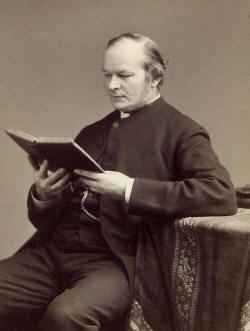

Queer Places:
University of Cambridge, 4 Mill Ln, Cambridge CB2 1RZ
Harrow School, 5 High St, Harrow, Harrow on the Hill HA1 3HP
Marlborough College, Bath Rd, Marlborough SN8 1PA
Westminster Abbey, 20 Dean’s Yard, Westminster, London SW1P 3PA
Canterbury Cathedral, 11 The Precincts, Canterbury CT1 2EH, UK
 Frederic William Farrar (Bombay, 7 August 1831 – Canterbury, 22 March 1903) was a cleric of the Church of England (Anglican), schoolteacher and author. He was a member of the
Cambridge Apostles secret society. He was the Archdeacon of Westminster from 1883 to 1894, and Dean of Canterbury Cathedral from 1895 until his death in 1903.
The bestselling Eric, or Little by Little (1858) by Farrar – known to
Algernon Charles
Swinburne as ‘Dr Thwackum of Marlborough’ – was
deemed suspiciously effeminate by The Saturday Review: ‘to the infinite
indignation of all English readers, [the boys] occasionally kiss each other
(principally however when they are in articulo mortis [at the point of death])
exchanging moreover such endearments as “dear fellow” and the like’. But even
Eric drew a line between beastliness and passion. Eric and Edwin may
‘[squeeze] each other’s hands, and [look] into each other’s faces’, but any
boy who oversteps the mark is condemned as a servant of the Devil and a
spreader of ‘moral turpitude’.
Frederic William Farrar (Bombay, 7 August 1831 – Canterbury, 22 March 1903) was a cleric of the Church of England (Anglican), schoolteacher and author. He was a member of the
Cambridge Apostles secret society. He was the Archdeacon of Westminster from 1883 to 1894, and Dean of Canterbury Cathedral from 1895 until his death in 1903.
The bestselling Eric, or Little by Little (1858) by Farrar – known to
Algernon Charles
Swinburne as ‘Dr Thwackum of Marlborough’ – was
deemed suspiciously effeminate by The Saturday Review: ‘to the infinite
indignation of all English readers, [the boys] occasionally kiss each other
(principally however when they are in articulo mortis [at the point of death])
exchanging moreover such endearments as “dear fellow” and the like’. But even
Eric drew a line between beastliness and passion. Eric and Edwin may
‘[squeeze] each other’s hands, and [look] into each other’s faces’, but any
boy who oversteps the mark is condemned as a servant of the Devil and a
spreader of ‘moral turpitude’.
Farrar was born in Bombay, India, and educated at King William's College on the Isle of Man, King's College London and Trinity College, Cambridge.[1] At Cambridge he won the Chancellor's Gold Medal for poetry in 1852.[2] He was for some years a master at Harrow School and, from 1871 to 1876, the headmaster of Marlborough College. Farrar spent much of his career associated with Westminster Abbey. He was successively a canon there, rector of St Margaret's (the church next door), archdeacon of the Abbey. He later served as Dean of Canterbury;[3] and chaplain in ordinary, i.e. attached to the Royal Household.[4] He was an eloquent preacher and a voluminous author, his writings including stories of school life, such as Eric, or, Little by Little and St. Winifred's about life in a boys' boarding school in late Victorian England, and two historical romances. Farrar was a classics scholar and a comparative philologist, who applied Charles Darwin's ideas of branching descent to the relationships between languages, engaging in a protracted debate with the anti-Darwinian linguist Max Müller.[5] While Farrar was never convinced by the evidence for evolution in biology, he had no theological objections to the idea and urged that it be considered on purely scientific grounds.[6] On Darwin's nomination, Farrar was elected to the Royal Society in 1866 for his philological work. When Darwin died in 1882, Farrar helped get the church's permission for him to be buried in Westminster Abbey and preached the sermon at his funeral.[6] He was one of ten pallbearers at the funeral; the others were: The Duke of Devonshire, The Duke of Argyll, The Earl of Derby, Mr. J. Russell Lowell, Mr. W. Spottiswoode, Sir Joseph Hooker, Mr. A. R. Wallace, Professor Huxley, and Sir John Lubbock.[11][12]
On 1 August 1860 at St Leonard's Church, Exeter, he married Lucy Mary Cardew; they had five sons and five daughters:[11] Reginald Anstruther Farrar (1861-), Evelyn Lucy Farrar (1862-), Hilda Cardew Farrar (1863-1908), Maud Farrar (1864-1949), Eric Maurice Farrar (1866-), Sibyl Farrar (1867-), Cyril Lytton Farrar (1869-), Lilian Farrar (1870-), Frederic Percival Farrar (1871-1946), Ivor Granville Farrar (1874-1944) (born Bernard Farrar). The first eight were born at Harrow; the last two were born at Marlborough. The second daughter, Hilda, was married in 1881 to John Stafford Northcote, vicar of St Andrew's, Westminster. He was the third son of Stafford Northcote, 1st Earl of Iddesleigh and their son Henry succeeded as third Earl in 1927. Farrar allowed his third daughter, Maud, to become engaged to Henry Montgomery at 14 and marry at 16. Farrar was then archdeacon of St Margaret's and Montgomery was the curate; Montgomery went on to become Bishop of Tasmania. Their children included the World War II hero "Monty", Field Marshal The 1st Viscount Montgomery of Alamein.[13] Farrar's son Reginald published his biography in 1902.[6]
Farrar died on 22 March 1903, and was buried in the cloister of the Canterbury Cathedral.[11] Farrar has a street named after him – Dean Farrar Street in Westminster, London. There is also a memorial to him at the church of St Margaret's, Westminster by the sculptor Nathaniel Hitch.
My published books: